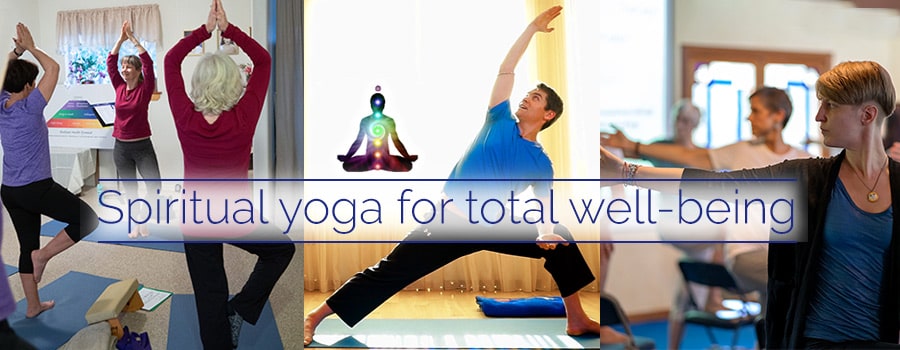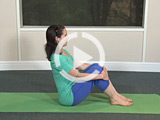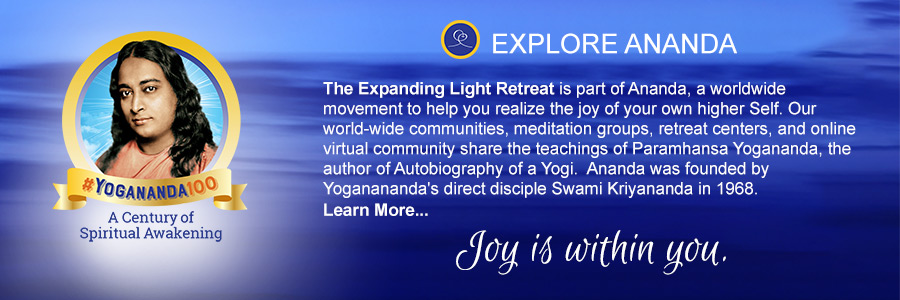The Perfect Yoga Warm-Up
What does it mean to “warm up” the body? It means preparing the body to perform physical tasks efficiently with a minimal risk of injury. Scientific studies have provided evidence of the importance of warming up the body to prevent injuries. Without warming up physically, the body will perform poorly, and be at increased risk of injury.
It’s like trying to start an old fashioned car without warming it up: it sputters and dies. It is like trying to cook a pancake on a skillet that is not warmed up yet. It takes a long time to get your result (a cooked pancake to eat), and by the time it finally is done it will be dried out and tough. It is like… okay, so you get the point.
Warming up for hatha yoga has an additional purpose: to prepare the mind to be centered, calm, and focused. A distracted mind prevents the practitioner from reaping the deepest psychological and spiritual benefits from yoga practice. It also prevents one from paying attention to the body as it sends out signals of distress which, if unheeded, can bring about injury.
Asanas as Warm-Ups
So we know that we should warm up at the beginning of our yoga practice. Then why not just use stretching asanas as our warm-ups? After all, isn’t stretching what runners and other athletes do before their workouts?
True, many athletes are doing exactly that. However, a recent study conducted by the U.S. Centers for Disease Control and Prevention (CDC) concluded that stretching before an activity does not prevent injuries. A New York Times article that reported this study last spring went on to discuss why stretching alone does not warm up the body sufficiently for physical activity.
“Warming up, which typically means raising the body temperature enough to send the blood flowing through the muscles, requires more intense activity than stretching.”
The article quoted Dr. Stephen B. Thacker, a CDC author of the study, “If you put on your sweats and simply start stretching, your muscles are not necessarily warmed up.”
Then why do so many people continue to stretch before physical activity as a warm-up? After all, the above study is not a cutting edge discovery; it was a compilation of many studies done over nearly sixty years. It seems that pre-workout stretching is simply one more example of a popular activity that even the “experts” once touted as the thing to do for injury prevention and peak performance — and people are slow to change their beliefs despite evidence to the contrary.
The original theory of stretching being a good way to warm up was just that: a theory that became popular before being tested. It reminds us that the mere fact that “everybody’s doing it” does not make it true or a good thing to do. This brings to mind some words from “Truth Can Never Die,” one of Swami Kriyananda’s songs: “Oh, never mind if men are wrong, so long as they agree!”
In fact, the current vogue to warm up by stretching is actually backwards: we need to warm up in order to stretch! Or to put it another way, it’s best not to stretch a cold muscle. In fact some experts cited in the above article recommend stretching after aerobic activity rather than before. Most experts seem to agree that some stretching is beneficial for athletic performance, but there is still disagreement as to how much is needed.
Good Things Happen When You Warm Up Properly
What makes a good warm-up? If we can understand the physiological mechanisms of warming up the body, then we will under-stand why stretching is not how we want to start — and we will also be able to understand what we need to do to warm up properly.
Stimulation of Circulation
The most important function of warming up is the stimulation of the circulation of blood throughout the body. With the start of muscular contraction, the heart rate rises, thus increasing circulation. (Interestingly, even just the thought of performing a muscular contraction will cause the heart rate to rise, so some authorities hypothesize that the increased heart rate is the result of psychic stimuli acting on the medulla oblongata.)
This brings oxygen and other fuels to the muscle cells, which enables the cells to continue working (contracting). As the fuels are “burned” in the cells, about 25% of the energy released is used for muscle contraction; the other 75% of the energy is released as heat.
Warming up also gives the blood vessels in the muscles time to dilate and thus increase the blood flow, making a greater supply of oxygen available to the muscles for more-demanding exercise. When the oxygen supply for the task is inadequate, the muscles cannot perform at their optimal level; in addition to diminished muscle strength and/or endurance, there is a greater risk of injury and muscle soreness.
Synovial Fluid
Adequate warm-ups also stimulate the synovial fluid in the joints. Synovial fluid is a viscous (“thick”) fluid within a joint cavity. It provides protective cushioning and lubrication within a joint. It also brings nutrients to joint tissues that have no direct blood supply. The amount of water in the joints goes up and down with exercise and rest. If joints are stretched suddenly, even the fluid does not fill all the space and the lining may jump into the vacuum formed, which is how people “click” their finger joints.
“Cartilage has no blood supply,” explains P. Z. Pearce, MD, a sports medicine expert quoted by the Group Health Cooperative.
“When you move your joints, the cartilage soaks up the synovial fluid inside the joint like a sponge.” This action draws more water and nutrients into the capsule. Moving a joint through its full range of motion is thought to be the best way to activate the production of synovial fluid from the synovial membrane and increase the flow of nutrients into the capsule. In addition, waste products are released out of the capsule through the synovial membrane.
The stimulation of synovial fluid is especially important to older individuals and those whose injuries have resulted in a decreased flow of synovial fluid. After age 35, synovial fluid becomes thinner and we produce less of it, says Dr. Pearce. Also, many older individuals tend to become less active and therefore, are not maintaining the health of their joints as well as they could.
Breathing
Breathing is an important element in the warm-up process. The muscle contraction and release during deep, conscious breathing stimulates circulation, making fresh oxygen available to the muscles. Relaxed, deep breathing also calms the mind and reduces muscular tension. Muscles can perform more efficiently when we are breathing diaphragmatically without excess tension. Thus pranayamas are an excellent way to begin warming up.
Concentration
The warm-up process also serves to focus attention and enhance concentration. The warm-up period is a good time to evaluate and address one’s physical and/or mental tensions. Yoga warm-ups should prepare not only the body, but also the mind and the intuitive self, coordinating them to ensure maximum benefit from yoga practice.
The Value of Pauses
As mentioned above, warming up stimulates the body by carrying needed oxygen to the muscles via the blood. As we move into more demanding asanas, even more oxygen is needed, so our breath and heart rate naturally increase. When muscles are asked to perform beyond their normal capacity (which is necessary to build stronger muscles, though taking this to excess will cause injuries), the metabolic process that takes place during this effort puts the muscles into “oxygen debt.”
When the muscles rest after the effort ends, the “debt” is paid off as more oxygen is delivered; this helps prevent muscle soreness. When we pause after an asana until the breath returns to a normal rate, oxygen can then reach the muscles, which not only fuels subsequent muscle activity in the next asana, but helps prevent muscle soreness by paying off the oxygen debt in a timely manner.
Of course, this is also a time for bringing the energy deeper into the spine and to experience the gross and subtle energy benefits of the asana. However, care must be taken not to rest too long, or else the “warming up” effect — as well as concentration, perhaps — will be lost.
An Ideal Warm-Up Routine
What are the main requirements for a good warm-up routine? Well, it should:
- Activate all of the major muscle groups, thus warming up the muscles and stimulating the circulation.
- Move all the joints in the body in order to stimulate the synovial fluid.
- Involve conscious use of the breath to increase the efficiency of the exercises as well as to calm and center the mind.
- Take into account the time of day, weather, temperature, and one’s state of mind, as all of these factors influence the body.
- Accommodate special needs groups (seniors, pregnant women, etc.) via custom-tailored warm-ups. The Energization Exercises are ideally designed for these needs (in addition to all their more-profound benefits). Let’s take a closer look to see why.
After the opening prayer, which focuses the mind and opens one up to the spiritual aspects of the practice, the Energization Exercises begin with “double breathing, palms touching.”
The strong pranayama immediately brings in fresh oxygen that will be needed for warming up the body. It efficiently eliminates toxins by emptying the lungs of old, stale air from the lower lobes to make room for more fresh air, and thus more oxygen. In the meantime, muscles throughout the entire body are being contracted in a low-medium-high fashion, followed by a high-medium-low-full release. This is then repeated several times.
This action efficiently stimulates the circulation without requiring the muscles to overwork before being properly warmed up. Concurrently, many joints are being flexed and extended, which stimulates the synovial fluid in those joints without moving them into any extreme positions. Not a bad start at all!
The Energization Exercises continue to work up and down the body, so that every major group of muscles is activated and all the joints are moved. The physical energy is moved up the spine several times throughout the sequence, which helps us tune into the life-force and bring it inward and upward. This prepares us to do likewise (inward and upward) with the energy during our asana practice.
Since the muscles are never held in tension for a long period of time, applying the motto, “Tense with will, then relax and feel,” gives time for oxygen replenishment to the muscles as they alternately contract and relax. Also, whenever the heart rate and/or breath are greatly sped up during the exercises, there quickly follows an exercise that helps bring both back down naturally, while continuing with the warm-up.
For example, running in place, which increases the heart and breath rates, is immediately followed by the fencing exercise, which (a) does not demand as much oxygen, and (b) is coupled with the highly efficient double breath, so it eliminates any oxygen deficit quickly and brings the breath rate back down.
Another example of this is after Uddiyana Bandha (stomach recharging): the breath wants to quickly “catch up,” and the repeat of double breathing, palms touching immediately following it calms the breath down effectively — not by mere rest, but by controlled breathing.
The Energization Exercises become especially dynamic and effective as a warm-up when the other motto, “The greater the will, the greater the flow of energy,” is applied. As the energy flows, blood circulation is stimulated and the joints become well “oiled.” A half-hearted effort will result in a less warming warm-up, but done properly, there will be no question as to whether your body is warmed up or not when you have finished the exercises.
It sounds like these exercises must have been designed by a master! And of course, they were. Yogananda once said that if you were on a deserted island and had no other techniques but the Energization Exercises — and if you practiced them — you could reach enlightenment.
Just imagine — a warm-up so perfect that it enlightens you!
Energization in Your Classes
Now I know that some of you are saying, “Warming up with the Energization Exercises might be good advice for me personally, but I don’t think my students at the yoga studio — let alone my gym yoga class — will go for them.”
My response is, “Have you tried it? If you do it with enthusiasm, make it fun, and really get them participating, you may be pleasantly surprised to find a positive reaction.”
“But then,” you continue, “what about people with injuries, who should not be doing things like twisting their lower back like an old-fashioned washing machine, or pregnant women who should not be practicing Uddiyana Bandha and perhaps a couple other of the exercises?”
My response is that the Energization Exercises are like any other asanas or exercises, in that you may need to adapt certain ones for a particular person’s special needs.
For example, Yogananda said to apply low or medium tension to an injured area. Or if any tension at all would be painful or uncomfortable, one can use no tension at all: just mentally send energy to that area, visualizing it flowing there.
In the meantime, I urge you to consider using at least a few of the Energization Exercises as part of a warm-up routine for your students. Double breathing, palms touching is a great one that even your most athletic students will be able to relate to, as will some of your more delicate ones. Skull tapping and scalp massage are always fun to do.
Some of your own favorites would be good ones to try as well. Uddiyana Bandha is a traditional, but often forgotten, hatha yoga technique. When you explain its abdominal toning, digestive, and reproductive organ benefits — not to mention the subtle energetic benefits — your students will happily churn away as you encourage them to bring that energy inward and upward!
Remember, by not introducing your students to the Energization Exercises, you may be denying them not only a great warm-up routine, but an opportunity for Enlightenment!
Related
All authors are graduates of Ananda Yoga Teacher Training.






















